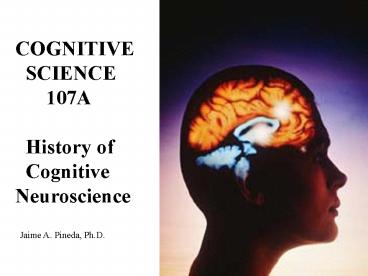History of Cognitive Neuroscience - PowerPoint PPT Presentation
1 / 23
Title:
History of Cognitive Neuroscience
Description:
Moves frog leg with static electricity. Detects electricity in the nerves of. frogs. Bell Magendi Law 1811. Doctrine of Specific Nerve Energies. Franz Joseph Gall ... – PowerPoint PPT presentation
Number of Views:248
Avg rating:3.0/5.0
Title: History of Cognitive Neuroscience
1
COGNITIVE SCIENCE 107A History of
Cognitive Neuroscience Jaime A. Pineda, Ph.D.
2
The Fundamental Circularity of Being
The world is inseparable from the subject, but
from a subject which is nothing but a projection
of the world, and the subject is inseparable from
the world, but from a world which the subject
itself projects. Merleau-Ponty (1906-1961)
3
BODY-MIND RELATIONSHIP(STRUCTURE-FUNCTION)
- BODY/BRAIN
- MIND
- Memory
- Attention
- Language
- Planning
- Creativity
- Awareness
- Consciousness
Classical physics
4
BODY-MIND RELATIONSHIP(STRUCTURE-FUNCTION)
- BODY/BRAIN
- MIND
- Memory
- Attention
- Language
- Planning
- Creativity
- Awareness
- Consciousness
Self-directed neural plasticity?
Quantum physics and the causal efficacy of
thought?
5
CLAUDIUS GALEN (ca. 131-201)
- Expanded Aristotles ideas of Humors
- The body is composed of a balance between the
four elements present on earth- fire, earth,
water, and air- which were manifested in the body
as yellow bile (choler), black bile (melancholy),
blood, and phlegm. - Galens psychic pneuma vital spirits
formed in the heart and were pumped to the brain,
where they mixed with pneuma (air found in the
cavities of the brain). - This modle held sway for 1500 years
6
Andreas Vesalius (1514-1564) De Humani
Corporis Fabrica (The Fabric of The Human Body)
1543 Studied anatomy solely for structure Did
not get some of the convolutions of the
brain right argued that Galen was wrong was
branded a heretic and fled.
7
(No Transcript)
8
Rene Descartes (1596-1650) De Homine
1662 Mechanistic view of brain Pineal gland
gateway to soul ingenuity and originality
were unfortunately based on pure speculation and
incorrect anatomical observations.
I think therefore I am
9
(No Transcript)
10
Luigi Galvani (1737-1798) Professor of
Obstetrics Moves frog leg with static
electricity Detects electricity in the nerves
of frogs
11
Bell Magendi Law 1811
12
Doctrine of Specific Nerve Energies
13
Franz Joseph Gall (1758-1828) Analysis of the
shapes and lumps of the skull would reveal a
persons personality and intellect.
14
Paul Broca (1824-1880) Anthropologist and
anatomist Paris educated MD pathologist Tan
aphasic patient died in April 1861 Nous parlons
avez lhemisphere gauche
15
Camillo Golgi (1843-1926)
Golgis silver chromate stain shows dendrites,
soma, and axons
16
Korbinian Brodmann (1868-1918) Established the
basis for comparative cytoarchitectonics of the
mammalian cortex.
17
Santiago Ramon y Cajal (1852-1934)
Father of Modern Neuroscience
Neuron Doctrine
18
Major Themes
- Behaviorism and Information theory
- Behavior as stimulus and response
- Cognitive Science Revolution
- The brain as a computer ? AI
- Processes acting on representations
- Connectionism (Parallel Distributed Processing)
- Gestalt School
- Behavior as organized wholes
19
Modern Phrenology
20
Imaging The Living Brain
- Computed Tomography (CT)
- Magnetic Resonance Imaging (MRI)
- Positron Emission Tomography (PET)
- Functional MRI (fMRI)
- Electroencephalography (EEG)
- Magnetoencephalography (MEG)
21
Functional MRI (fMRI)(1990s)
- Images brain hemodynamics
- Blood oxygen level dependent (BOLD) signal
- Advantages
- No injections given
- Structure and Function
- Shorter imaging time
- Better spatial resolution
- 3-D images
- Check out this website for more info on fMRI
methods http//www.fmri.org/fmri.htm
22
Summary
- Studying the adult human and animal brain gives
us some insights into how it works - Its a complex organ but its complexity is
intrinsic to itself and its parts - Highly specialized
- Division of labor
- Highly interactive
- Distributed cognition
However, this is not enough must study its
development and evolution (simple ? complex)
23
Sue Hespos, 2000 in Hot Science
- In the main, however, none of these methods has
been successful in answering even the most basic
questions of how the brain produces or encodes
mental activity. The main reason for this failure
has been the fact that these measures are asking
questions as the wrong level. The ultimate basis
of mental activity must be the informational
state of a huge collection of neurons
interacting, not en masse, but as an intricate
web, a network in which the details of the
intercommunicated information are salient.
Measures of integrated activity such as the EEG
or the EVBP simply do not assay the essence of
the relationship between mind and brain.































